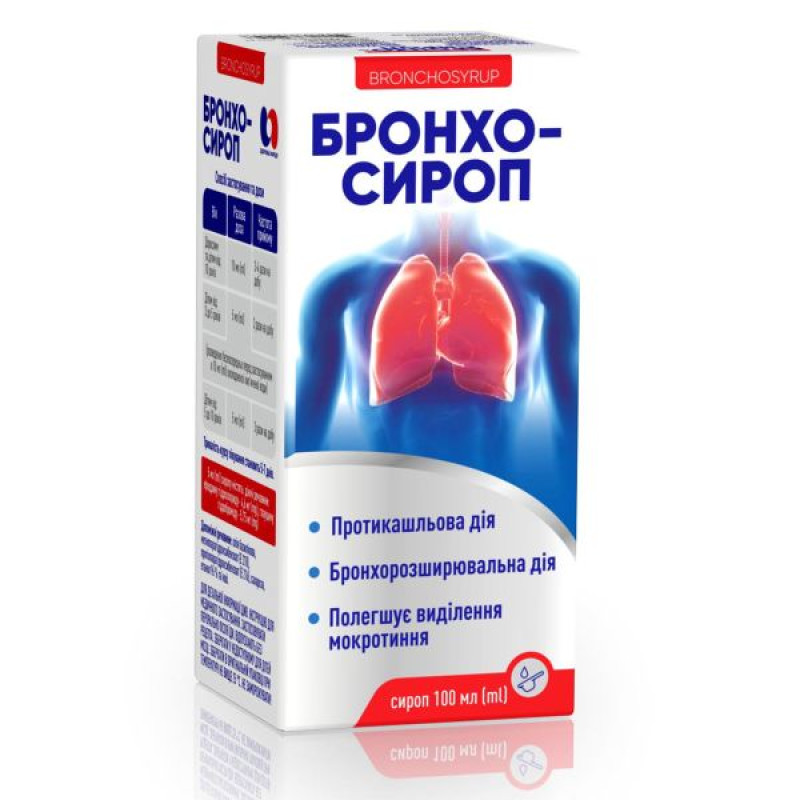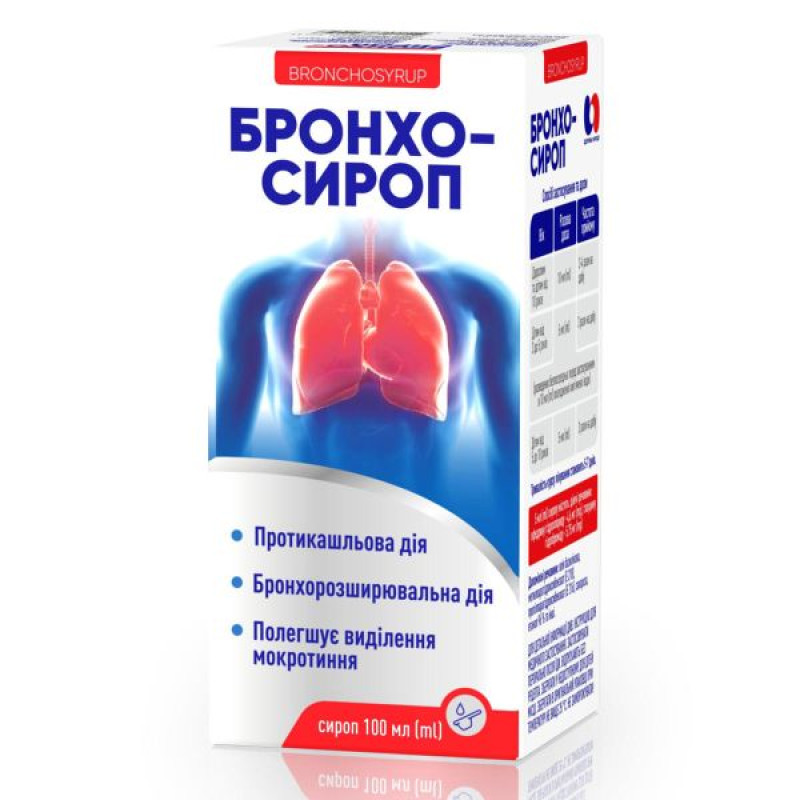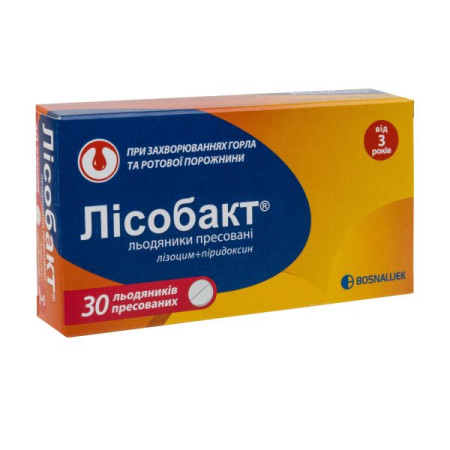Bronchosyrup bottle 100 ml

Instructions Bronchosyrop bottle 100 ml
Composition
5 ml of syrup contain:
active ingredients: ephedrine hydrochloride 4.6 mg, glaucine hydrobromide 5.75 mg;
Excipients: basil oil; citric acid, monohydrate; sucrose; methyl parahydroxybenzoate (E 218); propyl parahydroxybenzoate (E 216); polysorbate 80; ethanol 96%, purified water.
Dosage form
Syrup.
Main physicochemical properties: colorless or slightly brownish or brownish-yellowish viscous liquid with a specific smell of basil oil, opalescence is allowed.
Pharmacotherapeutic group
Drugs acting on the respiratory system. Other antitussives.
ATX code R05D B.
Pharmacological properties
Pharmacodynamics.
Bronchosyrop is a combined drug with a pronounced antitussive and bronchodilating effect. The complex effect of the drug is due to the properties of its main components: glaucine hydrobromide and ephedrine hydrochloride. The alkaloid glaucine suppresses the cough center without affecting the respiratory center. It has a weak bronchospasmolytic and adrenolytic effect, does not cause addiction and dependence if used in accordance with the section "Method of administration and dosage". Ephedrine is an adrenomimetic of direct (stimulates α- and β-receptors) and indirect (inhibits the activity of amino oxidase) action. Causes the release of noradrenaline and adrenaline from their depots. Ephedrine has an antispasmodic effect on the smooth muscles of the bronchi. For a long time, it relaxes the bronchial muscles, which is due to a pronounced stimulating effect on β2-adrenoreceptors. Under the influence of ephedrine, swelling of the bronchial mucosa decreases and their lumen expands. Pharmacological studies of Bronchosyrop show that it reduces the spastic effect of histamine on the bronchi.
Facilitating sputum discharge and bronchial dilation are due to the bronchodilating effect of ephedrine.
Pharmacokinetics.
Absorption: After oral administration, glaucine and ephedrine are rapidly and completely absorbed from the gastrointestinal tract.
Distribution: The maximum concentration of glaucine in blood plasma is reached 1.5 hours after administration.
Ephedrine is distributed throughout the body, accumulating primarily in the liver, lungs, kidneys, spleen, and brain.
Metabolism: Glaucine and ephedrine (a small part) are metabolized in the liver.
Excretion: Glaucine is excreted in the urine as metabolites and unchanged.
The half-life of ephedrine is approximately 3–6 hours. It is eliminated in the urine, mainly unchanged.
Indication
Bronchosyrup is used as part of complex therapy for diseases of the respiratory system that are accompanied by a dry, unproductive cough: acute and chronic bronchitis, tracheobronchitis, bronchial asthma, pneumonia, bronchiectasis.
Contraindication
- Hypersensitivity to the active substance or to any excipient of the medicinal product;
- ischemic heart disease;
- severe and/or uncontrolled arterial hypertension;
- acute myocardial infarction;
- severe organic heart disease with manifestations of decompensation;
- thyrotoxicosis;
- pheochromocytoma;
- closed-angle glaucoma;
- prostatic hypertrophy with urinary retention;
- insomnia.
Interaction with other medicinal products and other types of interactions
Bronchosyrup can be used simultaneously with antibiotics, antipyretics, and vitamins. It weakens the effects of narcotic and hypnotic drugs due to the presence of ephedrine in the composition of the drug.
When used simultaneously with cardiac glycosides, some sympathomimetics, quinidine, tricyclic antidepressants, halogenated anesthetics (halothane), the risk of developing cardiac arrhythmia increases. Similar effects can be observed with simultaneous use with ergot alkaloids or oxytocin. When used simultaneously with reserpine, a sharp increase in blood pressure is possible.
Because ephedrine has both α-agonist and β-agonist properties, it should be used with caution in patients who have undergone anesthesia with cyclopropane, halothane, or other volatile anesthetics.
Ergot alkaloids, monoamine oxidase inhibitors (MAOIs) and oxytocin potentiate the pressor effect of ephedrine (risk of hypertensive crisis with concomitant use). If treatment with the drug is necessary, a two-week interval should be observed after discontinuation of MAO inhibitors.
When used simultaneously with non-selective β-blockers, the bronchodilator effect of the drug is reduced.
Sympathomimetics have an antagonistic effect on the antihypertensive effect of β-blockers.
Ephedrine may counteract the neuroblocking effect of guanethidine, leading to a loss of its hypotensive efficacy.
Ephedrine accelerates the metabolism of dexamethasone.
With simultaneous treatment with Bronchosyrop and oral antidiabetic drugs, a decrease in their hypoglycemic effect is possible.
Concomitant use of ephedrine with theophylline may lead to increased nausea, nervousness, and insomnia.
Other central nervous system (CNS) stimulating drugs or tonic drinks of herbal origin (coffee, tea, Coca-Cola) may enhance the CNS stimulating effects of Bronchosyrop when used simultaneously.
In patients with hypertension receiving concomitant therapy with ephedrine and adrenergic neuron-blocking drugs, loss of blood pressure control has been reported, which may also occur with other antihypertensive agents.
There is an increase in the vasoconstriction and pressor effects of ergotamine or methysergide; simultaneous use of ergotamine is not recommended (risk of gangrene).
The effects of ephedrine can be reduced by acidification and increased by alkalinization of the urine.
Application features
Due to the stimulating effect on the CNS and possible sleep disturbance, taking Bronchosyrop after 4 p.m. is not recommended.
Prescribe with caution to patients with diabetes mellitus and renal failure.
Use with caution in patients prone to developing drug dependence.
If symptoms do not disappear or the condition worsens after 5–7 days of treatment, you should consult a doctor to assess the feasibility of further treatment.
Cardiovascular effects may occur with sympathomimetics, including Bronchosyrop. Post-marketing data and literature support the association of rare cases of myocardial ischemia with the use of β-agonists (ephedrine hydrochloride). Patients with heart disease (ischemic heart disease, arrhythmia, or heart failure) who are taking this drug should be advised to seek medical attention if chest pain or other symptoms of heart disease occur. Special attention should be paid to the evaluation of symptoms such as dyspnea and chest pain, as they may be of both respiratory and cardiac origin.
Glaucine hydrobromide should not be used in productive coughs accompanied by sputum production, as there is a risk of bronchial obstruction due to bronchial secretion retention. In case of labile blood pressure, a doctor's consultation is necessary. The drug should be used with special caution in patients with arterial hypertension and prostatic hyperplasia. Use with caution due to the risk of collapse as a result of the sympatholytic effect of glaucine hydrobromide.
Children and the elderly are more sensitive to the effects of ephedrine.
After prolonged use of ephedrine, tolerance with the development of dependence is observed.
People with known intolerance to some sugars should consult their doctor before taking this medicine. The medicine may be harmful to the teeth.
This medicinal product contains a small amount of ethanol 96%: less than 100 mg/5 ml dose.
This medicinal product contains 1.7 vol. % ethanol, i.e. 138 mg/10 ml dose. Harmful for patients suffering from alcoholism. Caution should be exercised when used in pregnant and breastfeeding women, children and patients with liver disease and epilepsy.
The syrup contains the excipients methyl parahydroxybenzoate (E 218) and propyl parahydroxybenzoate (E 216), which may cause allergic reactions (possibly delayed).
The content of ephedrine in the product may give a positive result in a doping test in athletes.
Use during pregnancy or breastfeeding
It is contraindicated to use in the first trimester of pregnancy and during breastfeeding.
There are no data on the safety of use during the second trimester, so it is recommended to use only in cases where the benefit to the mother outweighs the potential risk to the fetus.
If ephedrine is used during the last trimester, it may cause an increase in the fetal heart rate.
Ability to influence reaction speed when driving vehicles or other mechanisms
The drug should be used with caution when driving or operating automated machinery due to the action of ephedrine. Ephedrine may cause mydriasis and affect the speed of reaction when driving or operating machinery.
Method of administration and doses
Administer orally after meals.
Adults and children over 10 years of age: 10 ml 3–4 times a day.
For children:
- aged 3 to 5 years - 5 ml of syrup, diluted immediately before use in 10 ml of cooled boiled water, 3 times a day;
- aged 5 to 10 years - 5 ml 3 times a day.
The duration of the treatment course is 5–7 days.
Children.
Recommended for children aged 3 and up.
Overdose
Overdose may cause nausea, vomiting, fever, loss of appetite, nervous excitement, tremor of the limbs, dizziness, increased sweating, difficulty urinating, increased blood pressure, decreased blood pressure, headache, drowsiness, weakness, rapid fatigue, increased manifestations of adverse reactions, paranoid psychosis, delusions, hallucinations.
Treatment: gastric lavage, use of activated charcoal and symptomatic treatment.
Adverse reactions
When using the drug Bronchosyrop, the following undesirable reactions may occur:
from the immune system: hypersensitivity reactions (skin rash, urticaria, itching, angioedema, bronchospasm);
from the respiratory system, chest organs: dyspnea;
from the cardiovascular system: heart rhythm and conduction disorders, tachycardia, extrasystole, arrhythmia, palpitations, increased blood pressure, myocardial ischemia, pain behind the sternum, circulatory disorders in the extremities;
from the nervous system: headache, tremor, agitation, anxiety, restlessness, insomnia, sedation, dizziness;
from the digestive system: dry mouth, anorexia, nausea, vomiting, constipation;
Urinary system: difficulty urinating, urinary retention is possible in patients with prostatic hypertrophy;
Skin and mucous membranes: increased sweating;
from the sensory organs: visual impairment;
others: shortness of breath, weakness, increased libido, dysmenorrhea, tachyphylaxis, tolerance with the development of addiction (with prolonged use).
Myocardial infarction is very rare in patients taking ephedrine or pseudoephedrine.
Ephedrine may act as a stimulant in children with nocturnal enuresis and cause insomnia, and may also have a sedative effect on some children.
Reporting of adverse reactions.
Reporting adverse reactions after the registration of a medicinal product is important. This allows monitoring of the benefit/risk ratio when using this medicinal product. Medical and pharmaceutical professionals, as well as patients or their legal representatives, should report all cases of suspected adverse reactions and lack of efficacy of the medicinal product via the Automated Information System for Pharmacovigilance at the link: https://aisf.dec.gov.ua.
Expiration date
2 years.
The shelf life after opening the bottle is 1 month.
Storage conditions
Store in the original packaging at a temperature not exceeding 25 °C.
Keep out of reach of children.
Do not freeze!
Packaging
Syrup 100 ml or 200 ml in a bottle. 1 bottle together with a dosing device in a cardboard box.
Vacation category
Without a prescription.
Producer
Limited Liability Company "Kharkiv Pharmaceutical Enterprise "People's Health".
Location of the manufacturer and address of its place of business.
Ukraine, 61002, Kharkiv region, Kharkiv city, Kulykivska street, building 41.
There are no reviews for this product.
There are no reviews for this product, be the first to leave your review.
No questions about this product, be the first and ask your question.
















